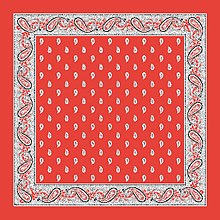Glarner Tüechli
Glarner Tüechli are colored, square cotton towels with patterns that are traditionally produced in the Swiss canton of Glarus . The basic color is often red, but it can be anything, the dimensions vary between 50 × 50 cm to 70 × 70 cm.
As a rule, the square center field is printed with patterns that are based on traditional oriental ornaments. The middle field is framed by an ornamental border . The colors of the individual cloth are usually limited to the basic color, as well as black, gray and white for the design .
They are used as fashion accessories , as a headscarf and neck scarf , rolled up as a headband , as a napkin or as a sturdy handkerchief . The design of traditional Glarus towels is now marketed as tourist souvenirs on paper napkins, porcelain, dog collars, belts, accessories and more.
history
In the 17th century, seafarers brought color printed fabrics from India to Europe. These cotton prints called " indiennes " caused a sensation with their lively patterns and their splendid colors and found great sales as clothing fabrics, furniture covers and wall coverings.
After 1678 factories were set up in Holland, England and Germany which printed cotton fabrics in the Indian way. Huguenots who fled France did a lot of building work. In the Swiss Confederation they founded the first stuff printing works , in 1691 in Geneva and 1715 in Neuchâtel. Soon other printing plants were set up in Aargau, Bern, Basel and Zurich. 1740 in Glarus and 1765 in Islikon. After 1750, fabric printing flourished in France and in the 19th century England, the canton of Glarus and the Mühlhausen region developed into the most important centers of fabric printing in Europe.
Time-consuming hand printing with wooden models remained dominant well into the 19th century. However, inventive minds have been trying, with increasing success, to mechanize the printing process to increase production since 1780. The triumphant advance of chemical dyes after 1860 was just as significant. At the same time, machine textile printing took off in many countries, and gradually it completely supplanted the old hand printing with models.
The unique upswing in the Glarus textile industry began after 1815. In the Glarner Unter- and Mittelland numerous large and small fabric printing shops started operations. After 1822 over 20 spinning and weaving mills set up shop on the Linth and its tributaries .
Glarus trading companies and the manufacturers themselves took care of the worldwide distribution of the stuff prints. They repeatedly opened up new sales areas by doing real market research and carefully adapting their articles to customer requirements. This development reached its peak around 1865. Of the approximately 35,000 inhabitants of the canton of Glarus, 6,250 worked in the 22 stuff printing plants, with women, daughters and boys making up over half of the workforce. They printed around 48 million meters of fabric in one year, mainly by hand. At that time, Glarus took first place among the Swiss cantons in fabric printing, second in white weaving and third in cotton spinning. This one-sided industrial development soon had negative consequences, especially since the printing works were completely dependent on exports and were therefore susceptible to crises.
Manufacturer
One of the oldest, still existing manufacturers is the Blumer company in Niederurnen . However, many dealers also have production in East Asia .
Individual evidence
- ↑ www.f-blumer.ch ( Memento of the original from November 20, 2011 in the Internet Archive ) Info: The archive link was inserted automatically and has not yet been checked. Please check the original and archive link according to the instructions and then remove this notice.
